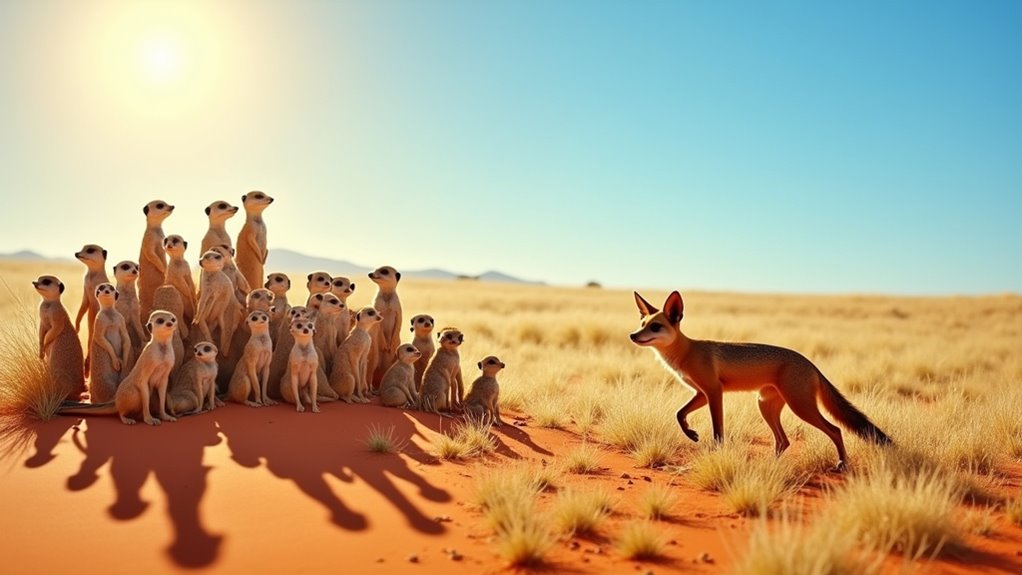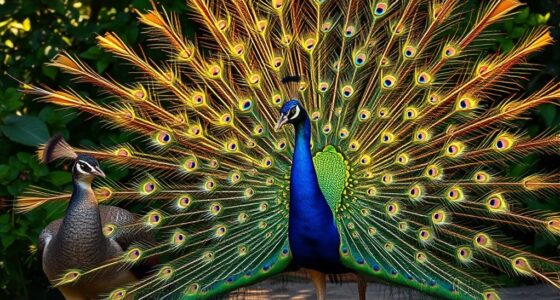Animals choose to live in groups or alone based on survival benefits, ecological needs, and evolutionary advantages. Living in groups helps with protection, hunting, and passing on skills, increasing chances of survival. On the other hand, solo lifestyles reduce competition, help avoid conflicts, and suit environments with scarce resources. Both strategies have evolved to fit different habitats and threats. If you keep exploring, you’ll discover even more about why these choices matter for animals’ survival.
Key Takeaways
- Animals in high-threat environments benefit from group living for protection and cooperative defense.
- Solitary lifestyles are advantageous in resource-scarce habitats, reducing competition and conflict.
- Social bonds enhance survival skills, reproductive success, and group cohesion over time.
- Environmental factors and ecological pressures influence whether animals adopt social or solitary strategies.
- Both strategies are evolutionary adaptations to maximize survival based on specific ecological needs.

Many animals choose to live either alone or in groups, depending on their species and environment. If you observe animals in the wild, you’ll notice that some thrive in tight-knit communities, while others prefer solitude. This choice often hinges on how they maximize their survival chances through social bonding and predator defense. When animals live in groups, social bonding becomes a key factor. These animals develop complex relationships, communicate through vocalizations and body language, and work together to care for their young. Such bonds create a sense of security and stability, making it easier to face threats. For example, primates and social carnivores like wolves depend heavily on these bonds to coordinate hunts and defend themselves against predators. Living in groups means that individuals can alert each other to danger quickly, increasing the collective predator defense. When a predator approaches, the entire group often reacts swiftly, making it harder for the predator to isolate and catch a single animal. This shared alert system improves survival odds for everyone involved. Additionally, group living can facilitate learning and passing down survival skills within the community. Social bonds are essential in maintaining group cohesion and effectiveness. In some species, group living also influences their reproductive success, which is crucial for their survival. Moreover, the social environment can influence an animal’s behavioral development and adaptability over time.
On the other hand, some animals prefer to go it alone because their survival strategies don’t rely as heavily on social bonding. These solitary creatures often avoid the costs associated with group living, such as competition for resources or the spread of disease. Instead, they focus on individual predator defense tactics, which can include camouflage, rapid movements, or nocturnal habits to stay hidden from threats. For instance, many big cats like tigers and leopards are solitary hunters. They rely on stealth and their ability to blend into their surroundings to avoid predators and catch prey. Their independence allows them to cover large territories, reducing competition and making it easier to find enough food without having to share. While they miss out on the safety net of collective alertness, their solitary lifestyle minimizes conflicts with others and reduces the risk of disease transmission. Some solitary animals also use environmental features, such as dens or burrows, as a means of shelter from predators and harsh weather conditions. This solitary approach can be especially advantageous in resource-scarce environments where competition is fierce.
Ultimately, whether an animal lives alone or in groups depends on what offers the best chance of survival in its environment. Group-living animals benefit from social bonding and collective predator defense, which provide safety and support. Solitary animals, however, often rely on stealth and individual tactics to stay safe, avoiding the costs of social living. Understanding these survival strategies reveals how diverse and adaptable animals are, each choosing the life that best suits their needs. Whether in a pack or alone, each animal’s behavior is a reflection of its environment, evolutionary history, and the constant drive to survive. The balance between these lifestyles is a remarkable example of evolutionary adaptation driven by environmental pressures. Recognizing these patterns helps us appreciate the complexity of animal behavior and their ongoing adaptation to changing conditions.
Frequently Asked Questions
How Do Animals Decide Whether to Live Alone or in Groups?
You might wonder how animals choose to live alone or in groups. Their decision depends on evolutionary advantages, like protection, resource access, or raising offspring. Environmental influences, such as food availability or predator presence, also shape their choice. You’ll find that animals adapt their social behavior to maximize survival, balancing risks and benefits. So, their lifestyle is a strategic response to both evolutionary needs and environmental conditions.
Are There Any Animals That Switch Between Solitary and Social Lifestyles?
You might wonder if animals switch between solitary and social lifestyles. Many exhibit behavioral flexibility, adjusting their social habits based on environmental conditions or life stages. This adaptability offers evolutionary advantages, like better resource access or protection. For example, some mammals or birds change from solitary to social to improve survival chances. Such flexibility helps them thrive in variable environments, maximizing their chances of reproductive success and safety.
What Impact Does Habitat Change Have on Animal Social Behavior?
Imagine your world shrinking—habitat fragmentation forces animals to adapt quickly. When habitats change, animals must decide whether to band together or go solo, like travelers seeking new paths. Climate adaptation and habitat loss impact social behavior, often pushing species to form tighter groups or become solitary to survive. You see, habitat change acts as a catalyst, reshaping how animals interact, find resources, and endure in a shifting environment.
Do Social Animals Face More Risks Than Solitary Ones?
You might think social animals face more risks, but their group behavior actually offers benefits. With better predator detection, they spot threats sooner and respond quickly. However, they also face increased resource competition, which can lead to conflicts and exhaustion. Solitary animals avoid these issues but miss out on safety in numbers. So, whether risks are higher depends on the environment and how effectively they balance these factors.
How Do Young Animals Learn Social Behaviors From Their Parents?
Imagine you’re watching a young elephant mimic its mother’s drinking habits. You see how learning rituals and parental guidance shape social behaviors. Young animals observe and imitate, gradually understanding communication, cooperation, and boundaries. This process helps them develop vital skills for group life or independence. Through direct interaction and modeling, parents teach their offspring social cues, ensuring they’re prepared for their place in the animal world.
Conclusion
Just like a lone star shining in the vast night sky or a flock guiding each other through darkness, animals choose their paths based on survival and connection. Whether living in a bustling hive or flying solo across open skies, each choice symbolizes a balance between independence and unity. By understanding these symbols, you see that both paths reflect a deep instinct to thrive in a world that’s constantly changing. It’s nature’s way of reminding you that sometimes, strength is found in togetherness, and other times, in solitude.










